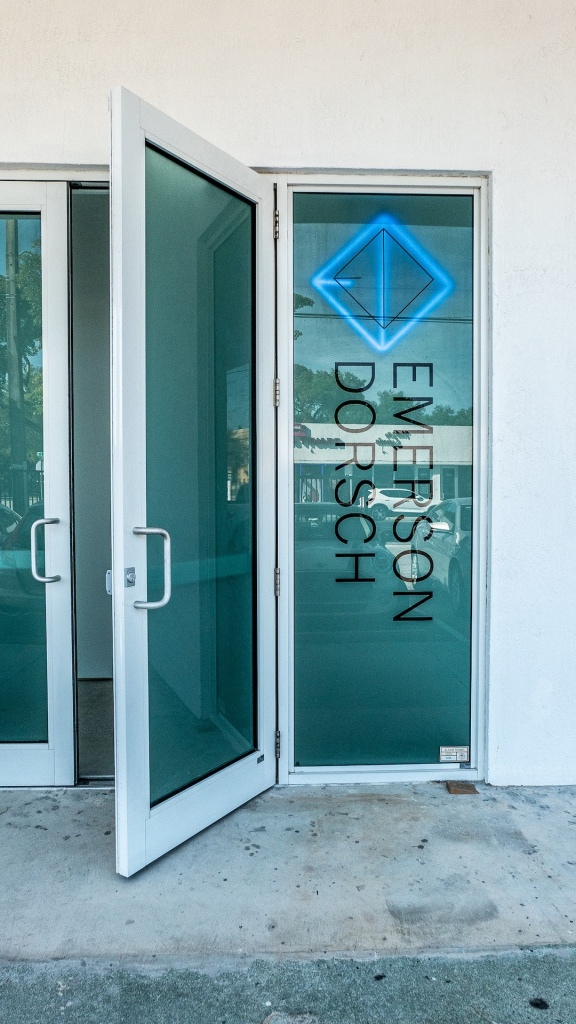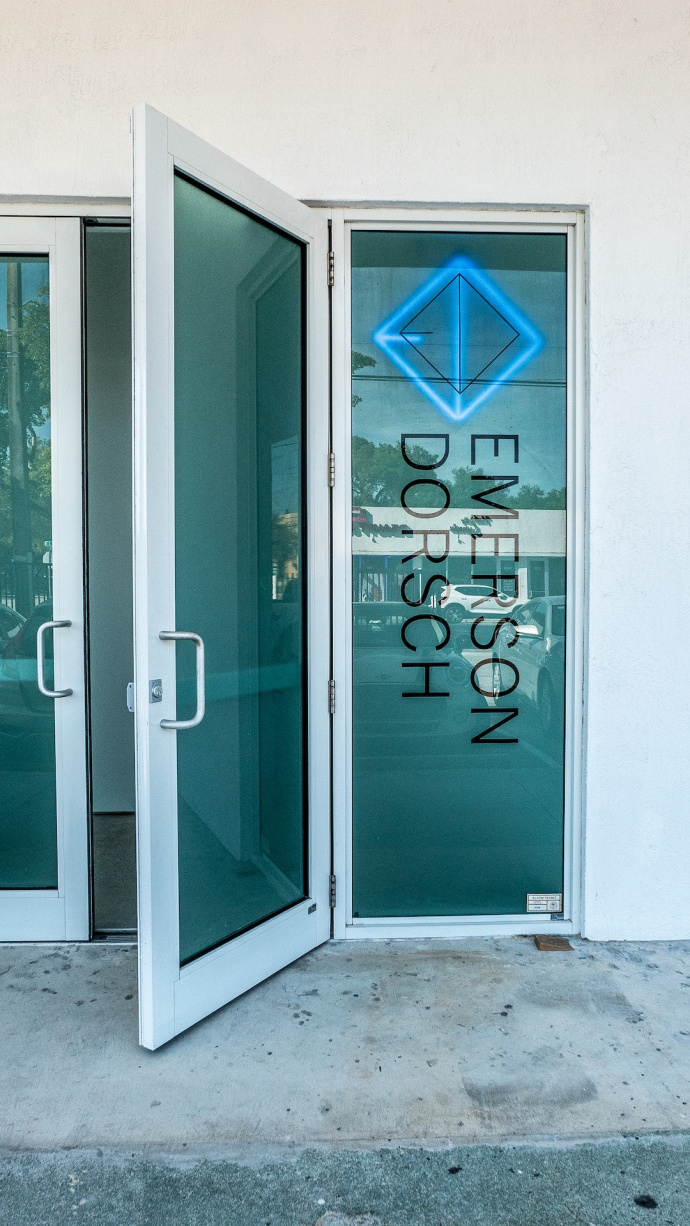Yanira Collado: Alchemic Chants/ Reliquías Fragmentadas, Emerson Dorsch Gallery

“My work attempts to assemble a visual language that reconciles the process in which the history of this information is recorded, stored, and retrieved.”
We are pleased to present Alchemic Chants/ Reliquías Fragmentadas, Yanira Collado’s first solo exhibition with Emerson Dorsch Gallery. A platform nearly covers the gallery floor, while objects and paintings punctuate the slim corridor around it. The platform echoes the footprint of a small house, one for living and for working. The platform also references the previous iterations of the gallery’s building, which was once Port au Prince Market, a neighborhood bodega. Collado continues to imbue her work with the stories of migration and subcultures, wrapping them in protective layers of cardboard, paint and fabric. Her work builds from fragmented stories of errantry as much as her ability to stand still and think in many directions. She places relics from a root – from her own life, the neighborhood, or a community – inside a house for contemplation. Yet, if a reliquary is a house for a relic, she’s turned the system inside out, an action that gets at the paradoxical nature of memory and identity.
WALLS OF RESISTANCE
Yanira Collado’s works are walls of resistance to the culture of explanation. Roughly traceable to the Western European Enlightenment drive to classify, label and map the world in an expression of colonial and imperial vectors, the culture of explanation was taken up with gusto by new Americans of the same mindset. (Never mind that there were already other ways of knowing the world.) Today the push to explain exists in the death of wonder, where answers are available in the top hits of an Internet search.
In this fashion, writing about Collado’s work feels irresponsible, for one has to avoid saying too much. Discretion. She gives us pieces of information to patch together, much like the tattered fragments of cloth floating amidst her heavily worked and layered surfaces. She builds them up so that they resemble decaying stucco walls found all around the Caribbean. But instead of recreating a CBS (concrete block structure), she builds up her surfaces from bits and pieces of disposable consumer culture, especially cardboard and drywall, along with standard repair fillers and cover-ups, like putty, white ceiling paint, and hole repair mesh. The fact that her works might be in conversation with Robert Rauschenberg’s combines or with Mark Bradford’s paintings confirms the artist’s own experience when encountering their approach to similar constructions. What the artists are trying to express has a similar form and style, like spirals in one culture and also another. Stay with Collado’s current; her specifics are important.
TAILORING
To her, taking a piece of fabric in her hands conjures days spent with her mother and father while they worked as seamstress and tailor for various fashion brands, from the generic mass-produced labels to Oscar de la Renta. At various times, her mother worked in a clothing production factory, in underground clothing production workshops in New York, and in a clandestine operation in her own house in the Dominican Republic. Seamstresses and tailors in these contexts are poorly paid, but they know their craft; they recognize the quality (or lack of) in the fabrics and their patterns. As a girl, Collado would listen as her mother and her compañeros worked and shared stories. She would play with scraps. Now, she will not sew. Instead, she embeds fabrics with glue and wheat paste over a support. Some of the fabrics have cheap reproductions of patterns once intricately made by artisans across the world. The only trace of their story is the pattern – in this case, paisley – first woven on the Indian subcontinent. That is to say, traces of migration and cultural exchange are hiding in plain sight, along with another kind of parallel universe in time and space in which those artisans may have been her mother and the women working alongside her.
TRAVELLING PATTERNS
Collado has in the past embedded photocopies of pictures of quilt patterns associated with coded communications to people fleeing slavery. Those patterns brought forward their makers’ memories of African patterns, their symbols and their meanings. The way the patterns’ reproductions scatter across her surfaces evoke stars in the sky where the spaces in between stretch like the distances in space and time between specific (beautiful, fierce, terrifying) stories and the worn traces we see.
There is a community of Persians in the Dominican Republic, where Collado’s family comes from and where Collado spent much of her childhood. They arrived in the D.R. several generations ago. Soon after Collado learned about their immigration story, she incorporated the paisley pattern into her work. It seemed so ubiquitous, and it was so cheap, that it took her a while to decide to learn more about the pattern’s origins. It became widely known when the British appreciated it, and then it was made for export; once this happened the West’s experience of the pattern became decoupled from the pattern’s origins. To draw from the ever-relevant Walter Benjamin, it lost its aura in serial and industrial reproduction which fed a widening system of distribution. Its entrance to trade funnels coincided with the acquisition of more associations until its stories were lost.
MATERIAL INTEGRITY
Scavenged materials have long been part of contemporary artists’ vocabulary, and Collado deliberates over every material she uses. The support and the back are as important as the face. Nothing is left to convenience or assumption. The physical laboring that goes into these works echo that of her father and uncles, and her material choices reflect her conviction that each so-called disposable thing has value throughout its life. She is interested in how the value of, say, a box changes with context, but at every point, it has value. She is a storyteller who embraces the roles her materials have to play. She embraces openness and recalibration, a meditative awareness of connections across space and time.
The inside – the unseen – is important as well. To the extent she embeds the patterns, she also hides components that have a spiritual role to play. Protection, she says, is part of her work.
_____
SELECT EXHIBITION REFERENCES
Ralph Waldo Emerson, “Persian Poetry,” downloaded from the internet.
Presumably first published in 1858 – see below:
Ralph Waldo Emerson. Entry in Encyclopedia Iranica. Last accessed 2 November 2021 at
https://iranicaonline.org/articles/emerson
Wikipedia entry on Iran, especially Persian poetry.
Edouard Glissant. Poetics of Relation. Translated by Betsy Wing. Ann Arbor: University of Michigan Press, 1997. Note that Oroza led me to Glissant.
Ernesto Oroza, “Four entrances to a Yanira Collado exhibit,” if they knew these things / reliquias ocultadas: Yanira Collado, Miami, FL: Dimensions Variable, 2020.
Ernesto Oroza, “ß,” Yanira Collado: Penumbras, North Miami, FL: Under the Bridge, 2018.
Ryan Dennis, “Seeing the Obvious, Revealing the Hidden: Yanira Collado in Conversation with Onajide Shabaka,” Bomb Magazine, accessed online, published 2019, on the occasion of group exhibition Round 49: penumbras: sacred geometries at Project Row Houses in Houston, TX.
Jennifer Ignacio with Yanira Collado. [Interview] “MY BODY, MY RULES | Performance 4 Ways, Yanira Collado,” August 25, 2021. https://www.youtube.com/watch?v=klQGBx7oCSM
Prentiss Clark, “What ‘No Chart Can Tell Us’: Ordinary Intimacies in Emerson, Du Bois, and Baldwin,” in James Baldwin Review. Manchester, United Kingdom; Manchester University Press, 2019. http://dx.doi.org/10.7227/JBR.5.3
Open access article.
Katy Siegel. Since ‘45. London: Reaktion Books, 2011.
Excerpt from “Seeing America,” a course on Khan Academy, reconsidering the art of North America.
This section is called “Fashioning Diplomacy: the Anishinaabe, Britain and 18th Century America”
https://www.youtube.com/watch?v=RKh6VxDULLA
Collado spoke about her attraction to the paisley pattern and its migration around the world. The example of glass beads reminds me of a similar cross-cultural impact, but with a reverse trajectory added.
Holland Cotter, obituary of Belkis Ayón, March 8, 2018.
https://www.nytimes.com/2018/03/08/obituaries/overlooked-belkis-ayon.html
Collado explicitly mentioned her affinity for Ayón.
Jorge Luis Borges, “The Circular Ruin,” Labyrinths: Selected Stories and Other Writings. Edited by Donald Yates and James Irby. New York, New Directions: 1964, 34th Printing. The Essay “The Circular Ruin” was translated from the volume Ficciones, published in Spanish by Emecé in 1956.
Walter Benjamin, “The Work of Art in the Age of Technological Reproduction.” In Illuminations, edited by Hannah Arendt, translated by Harry Zohn, from the 1935 essay. New York: Schocken Books, 1969. First published with the phrase “Mechanical Reproduction” in the title instead of a newer and interpretive translation. https://web.mit.edu/allanmc/www/benjamin.pdf
Jacqueline Tobin and Raymond G. Dobard, Ph.D. Hidden in Plain View: A Secret Story of Quilts and the Underground Railroad. New York, NY: Anchor Books, 2000.
Entry on “Sankofa.” https://www.uis.edu/africanamericanstudies/students/sankofa/ “Literally translated, this means “it is not taboo to go back and fetch what you forgot”.
About Yanira Collado
Yanira Collado (b. 1975, Brooklyn, NY; lives and works, Miami, FL). Born to Dominican parents, as a child, Collado traveled between Santo Domingo and Miami frequently, until 1992 when she attended Miami’s New World School of the Arts for high school. Collado studied at The School of the Art Institute and later on perused studies in Early Childhood Education.
Collado lives and works in North Miami, FL. Her artist residency fellowships include Bridge Red Art Center, North Miami, FL (2013-present), Project Row Houses, Houston, TX (2018), Oolite Arts, Miami Beach, FL (2019 – present), and the Joan Mitchell Foundation residency in New Orleans, LA (2020). She was awarded an Ellie Creator Grant from Oolite in 2019, first place in the 2013 South Florida Biennial at the Art and Cultural Center/Hollywood, FL and was named a Joan Mitchell Foundation fellow in 2018. Her work has been featured in numerous group shows, including Performance 4 Ways: MY BODY, MY RULES, Perez Art Museum, Miami, FL (2021), Estamos Bien La Trienal, El Museo, New York, NY (2021), AIM Biennial, Miami, FL (2020), Storage_, Storage Project Space, New York, NY (2020), Idioms and Taxonomies, Curated by Laura Marsh, Oolite Arts, Miami Beach, FL (2020), if they knew these things, Reliquias/Ocultadas, Dimensions Variable, Miami, FL (2020), Monarchs at the Museum of Contemporary Art, North Miami, FL (2018); Connectivity, Deconstruction, Patricia & Phillip Frost Art Museum, Florida International University, Miami, FL (2018); Transmissions, The Franklin, Chicago, IL (2016); Dirt, Florida Atlantic University, Boca Raton, FL (2016); and Ascent: Black Women’s Expressions, Nova University, Ft. Lauderdale, FL (2015).
Her work was pictured in Artforum.com’s Critic’s Pick, accompanying the review of Fragment, a group exhibition at Emerson Dorsch. In 2016, Collado had a one-person exhibit at the Museum of Art + Design at Miami Dade College, in collaboration with Bridge Red Studios. She had solo exhibitions with Under the Bridge and Farside Gallery in 2018. In 2020, she exhibited with Dimensions Variable, Miami, FL, Oolite Arts in Miami Beach, and Storage in NY. In 2019, an interview with her by Onajide Shabaka was published in BOMB Magazine. Collado is represented by Emerson Dorsch Gallery.
